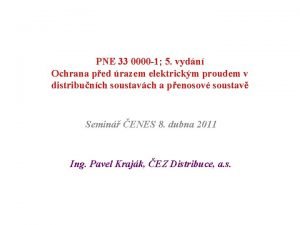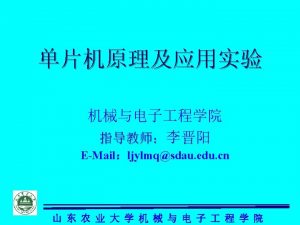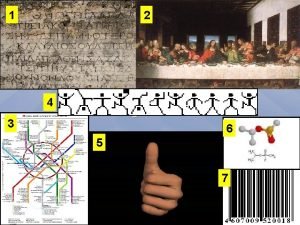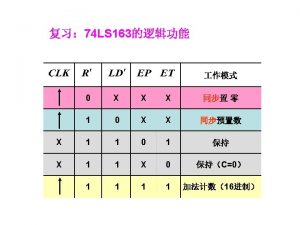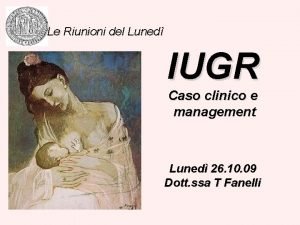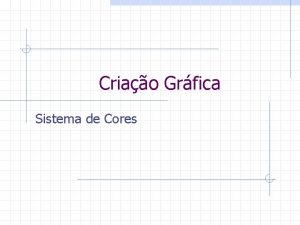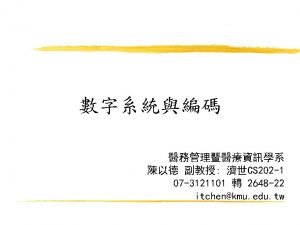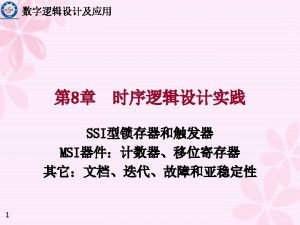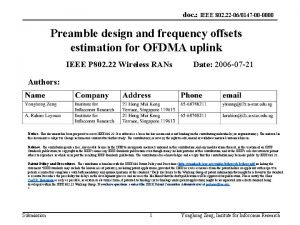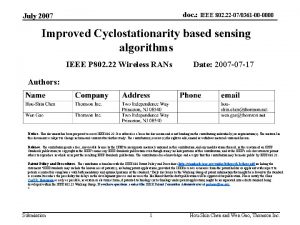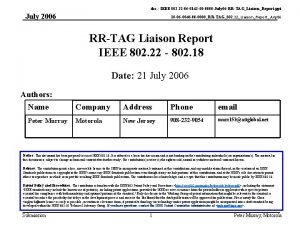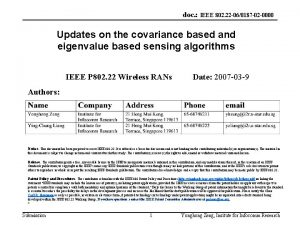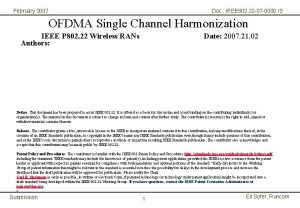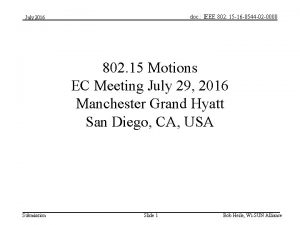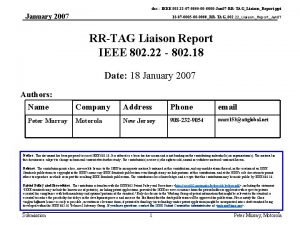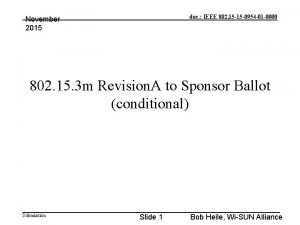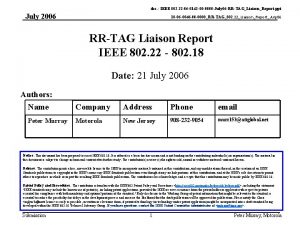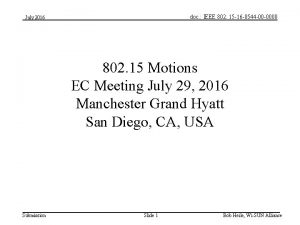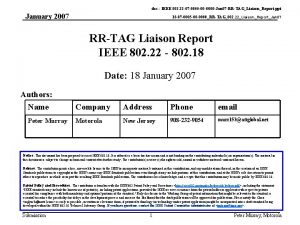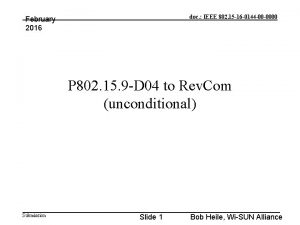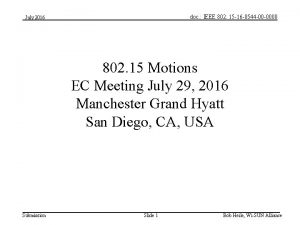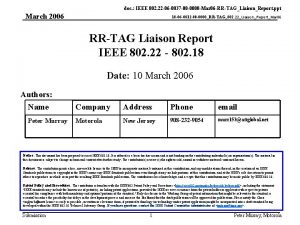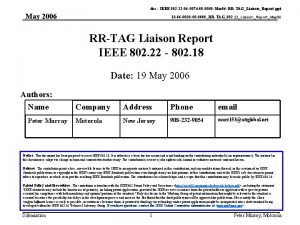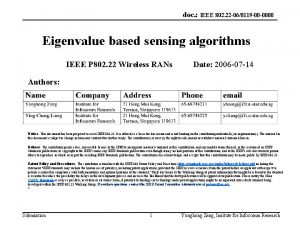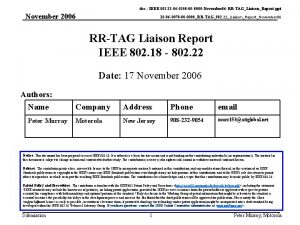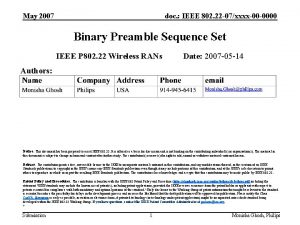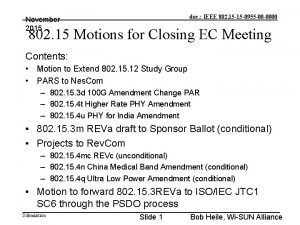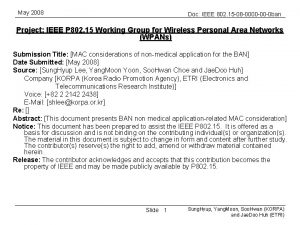doc IEEE 802 22 060186 00 0000 Performance


























- Slides: 26

doc. : IEEE 802. 22 -06/0186 -00 -0000 Performance of eigenvalue based sensing algorithms for detection of DTV and wireless microphone signals IEEE P 802. 22 Wireless RANs Date: 2006 -09 -18 Authors: Notice: This document has been prepared to assist IEEE 802. 22. It is offered as a basis for discussion and is not binding on the contributing individual(s) or organization(s). The material in this document is subject to change in form and content after further study. The contributor(s) reserve(s) the right to add, amend or withdraw material contained herein. Release: The contributor grants a free, irrevocable license to the IEEE to incorporate material contained in this contribution, and any modifications thereof, in the creation of an IEEE Standards publication; to copyright in the IEEE’s name any IEEE Standards publication even though it may include portions of this contribution; and at the IEEE’s sole discretion to permit others to reproduce in whole or in part the resulting IEEE Standards publication. The contributor also acknowledges and accepts that this contribution may be made public by IEEE 802. 22. Patent Policy and Procedures: The contributor is familiar with the IEEE 802 Patent Policy and Procedures http: //standards. ieee. org/guides/bylaws/sb-bylaws. pdf including the statement "IEEE standards may include the known use of patent(s), including patent applications, provided the IEEE receives assurance from the patent holder or applicant with respect to patents essential for compliance with both mandatory and optional portions of the standard. " Early disclosure to the Working Group of patent information that might be relevant to the standard is essential to reduce the possibility for delays in the development process and increase the likelihood that the draft publication will be approved for publication. Please notify the Chair Carl R. Stevenson as early as possible, in written or electronic form, if patented technology (or technology under patent application) might be incorporated into a draft standard being developed within the IEEE 802. 22 Working Group. If you have questions, contact the IEEE Patent Committee Administrator at patcom@iee. org. > Submission 1 Yonghong Zeng, Insitute for Infocomm Research

doc. : IEEE 802. 22 -06/0186 -00 -0000 Abstract • Sensing algorithms using the eigenvalues of the sample covariance matrix are presented • The methods can be used without knowledge of the signal, the channel and noise power • Simulation results based on the captured DTV signals and wireless microphone signals are presented • Comparisons with the energy detection are given Submission 2 Yonghong Zeng, Insitute for Infocomm Research

doc. : IEEE 802. 22 -06/0186 -00 -0000 Principle of the algorithms • The statistics of signal is different from that of noise • The difference is characterized by the eigenvalue distributions of the covariance matrix Submission 3 Yonghong Zeng, Insitute for Infocomm Research

doc. : IEEE 802. 22 -06/0186 -00 -0000 Flow-chart of the maximum-minimum eigenvalue (MME) detection Sample and filter the signals Choose a smoothing factor and the threshold r Compute the maximum eigenvalue and minimum eigenvalue of the covariance matrix Submission Compute the sample covariance matrix Transform the sample covariance matrix Decision: if the maximum eign >r*minimum eign, signal exists; Otherwise, signal not exists. 4 Yonghong Zeng, Insitute for Infocomm Research

doc. : IEEE 802. 22 -06/0186 -00 -0000 Flow-chart of the energy with minimum eigenvalue (EME) detection Sample and filter the signals Choose a smoothing factor and the threshold r Compute the average energy and minimum eigenvalue of the covariance matrix Submission Compute the sample covariance matrix Transform the sample covariance matrix Decision: if the energy >r*minimum eign, signal exists; Otherwise, signal not exists. 5 Yonghong Zeng, Insitute for Infocomm Research

doc. : IEEE 802. 22 -06/0186 -00 -0000 Advantages of the algorithms • No signal information is needed (compared to coherent detection) • Robust to multipath propagation (compared to coherent detection) • No synchronization is needed (compared to coherent detection) • No noise uncertainty problem (compared to energy detection) • Good performance (can be better than the ideal energy detection without noise uncertainty) Submission 6 Yonghong Zeng, Insitute for Infocomm Research

doc. : IEEE 802. 22 -06/0186 -00 -0000 Advantages of the algorithms • Same detection method for all signals (DTV, wireless microphone, …) • Same threshold for all signals (the thresholds is independent on the signal and noise power) Submission 7 Yonghong Zeng, Insitute for Infocomm Research

doc. : IEEE 802. 22 -06/0186 -00 -0000 Simulations for wireless microphone signals FM modulated wireless microphone signal (200 KHz bandwidth) The source signal is generated as evenly distributed real number in (-1, 1). We assume that the signal has been down converted to the IF with central frequency 5. 381119 MHz (the same as the captured DTV signal). The sampling rate is 21. 524476 MHz (the same as the captured DTV signal). The passband filter with bandwidth 6 MHz is the raised cosine filter with 89 tapes. The signal and white noise are passed through the same filter. Sensing time is 9. 30 mili seconds (ms). The smoothing factor is chosen as L=10. The threshold is set based on the required Pfa=0. 1 (using random matrix theory) and fixed for signals. The threshold is not related to noise power. Submission 8 Yonghong Zeng, Insitute for Infocomm Research

doc. : IEEE 802. 22 -06/0186 -00 -0000 Probability of detection (wireless microphone signals, sensing time 9. 30 ms) Submission 9 Yonghong Zeng, Insitute for Infocomm Research

doc. : IEEE 802. 22 -06/0186 -00 -0000 Probability of false alarm (filtered noise, sensing time 9. 30 ms) EG 2 d. B EG 1. 5 d. B EG 1 d. B EG 0. 5 d. B 0. 497 0. 496 0. 483 EG-0 d. B (no uncertainty) 0. 108 EME MME 0. 081 0. 086 EG-xd. B: energy detection with xd. B noise uncertainty. Submission 10 Yonghong Zeng, Insitute for Infocomm Research

doc. : IEEE 802. 22 -06/0186 -00 -0000 Simulations for captured DTV signals Based on the “Spectrum sensing simulation model”. The captured DTV signal is passed through a raised cosine filter (bandwidth 6 MHz, rolling factor ½, 89 tapes). White noises are added to obtain the various SNR levels. The number of samples used is 400000 (corresponding to 18. 60 ms). The smoothing factor is chosen as L=10. The threshold is set based on the required Pfa=0. 1 (using random matrix theory) and fixed for all signals. The threshold is not related to noise power. Submission 11 Yonghong Zeng, Insitute for Infocomm Research

doc. : IEEE 802. 22 -06/0186 -00 -0000 Probability of false alarm (white noise, sensing time 18. 60 ms) EG 2 d. B EG 1. 5 d. B EG 1 d. B EG 0. 5 d. B 0. 496 0. 491 0. 481 EG-0 d. B (no uncertainty) 0. 095 EME MME 0. 029 0. 077 EG-xd. B: energy detection with xd. B noise uncertainty. Submission 12 Yonghong Zeng, Insitute for Infocomm Research

doc. : IEEE 802. 22 -06/0186 -00 -0000 Probability of detection (WAS-311/48/01) Submission 13 Yonghong Zeng, Insitute for Infocomm Research

doc. : IEEE 802. 22 -06/0186 -00 -0000 Probability of detection (WAS-311/35/01) Submission 14 Yonghong Zeng, Insitute for Infocomm Research

doc. : IEEE 802. 22 -06/0186 -00 -0000 Probability of detection (WAS-311/36/01) Submission 15 Yonghong Zeng, Insitute for Infocomm Research

doc. : IEEE 802. 22 -06/0186 -00 -0000 Probability of detection (WAS-086/48/01) Submission 16 Yonghong Zeng, Insitute for Infocomm Research

doc. : IEEE 802. 22 -06/0186 -00 -0000 Probability of detection (WAS-006/34/01) Submission 17 Yonghong Zeng, Insitute for Infocomm Research

doc. : IEEE 802. 22 -06/0186 -00 -0000 Probability of detection (WAS-003/27/01) Submission 18 Yonghong Zeng, Insitute for Infocomm Research

doc. : IEEE 802. 22 -06/0186 -00 -0000 Probability of detection (WAS-051/35/01) Submission 19 Yonghong Zeng, Insitute for Infocomm Research

doc. : IEEE 802. 22 -06/0186 -00 -0000 Probability of detection (WAS-049/39/01) Submission 20 Yonghong Zeng, Insitute for Infocomm Research

doc. : IEEE 802. 22 -06/0186 -00 -0000 Probability of detection (WAS-032/48/01) Submission 21 Yonghong Zeng, Insitute for Infocomm Research

doc. : IEEE 802. 22 -06/0186 -00 -0000 Probability of detection (WAS-068/36/01) Submission 22 Yonghong Zeng, Insitute for Infocomm Research

doc. : IEEE 802. 22 -06/0186 -00 -0000 Probability of detection (WAS-049/34/01) Submission 23 Yonghong Zeng, Insitute for Infocomm Research

doc. : IEEE 802. 22 -06/0186 -00 -0000 Summary of the simulations • 11 of the 12 DTV signals in the “proposed subset of captures” (by Victor) were tested. (signal WAS-047/36/01 not found) • 9 of them obtain Pd >= 0. 9 at SNR lower than -20 d. B • Average Pd = 0. 87 at SNR -20 d. B • Best case is Pd > 0. 9 at SNR lower than -22 d. B • Worst case is Pd > 0. 9 at SNR -18 d. B Submission 24 Yonghong Zeng, Insitute for Infocomm Research

doc. : IEEE 802. 22 -06/0186 -00 -0000 Conclusions • The eigenvalue based detections do not need any information on signal, the channel, the noise level and SNR • Same detection method for all signals (DTV, wireless microphone, …) • Same threshold for all signals (the thresholds is independent on the signal and noise power) • Performance is comparable to ideal energy detection (can be better than if oversampled) Submission 25 Yonghong Zeng, Insitute for Infocomm Research

doc. : IEEE 802. 22 -06/0186 -00 -0000 References 1. A. Sahai and D. Cabric, “Spectrum sensing: fundamental limits and practical challenges, ” in Dyspan 2005 (available at: www. eecs. berkeley. edu/∼sahai), 2005. 2. Steve Shellhammer et al. , “Spectrum sensing simulation model”, http: //grouper. ieee. org/groups/802/22/Meeting_documents/2006_July/22 -06 -0028 -07 -0000 Spectrum-Sensing-Simulation-Model. doc, July 2006. 3. Steve Shellhammer, “Numerical spectrum sensing requirements”, http: //grouper. ieee. org/groups/802/22/Meeting_documents/2006_July/22 -06 -0088 -00 -0000 Numerical-Spectrum-Sensing-Requirements. doc, July 2006. 4. I. M. Johnstone, “On the distribution of the largest eigenvalue in principle components analysis, ” The Annals of Statistics, vol. 29, no. 2, pp. 295— 327, 2001. 5. Victor Tawil, “ 51 captured DTV signal”, http: //grouper. ieee. org/groups/802/22/Meeting_documents/2006_May/Informal_Documents , May 2006. Yonghong Zeng and Ying-Chang Liang, “Eigenvalue based sensing algorithms”, http: //grouper. ieee. org/groups/802/22/Meeting_documents/2006_July/22 -06 -0118 -000000_I 2 R-sensing. doc Submission 26 Yonghong Zeng, Insitute for Infocomm Research
 090-0000-0000
090-0000-0000 Bridges from 802.x to 802.y
Bridges from 802.x to 802.y Bridges from 802.x to 802.y
Bridges from 802.x to 802.y Estandares ieee 802
Estandares ieee 802 802 ieee
802 ieee Ieee 802 family
Ieee 802 family Ieee 802
Ieee 802 Ieee 802 standard
Ieee 802 standard Ieee 802
Ieee 802 Ieee 802 3 compliance
Ieee 802 3 compliance Arquitetura ieee 802
Arquitetura ieee 802 802 15
802 15 Ochrana polohou živých částí
Ochrana polohou živých částí Llll 0000
Llll 0000 0001 0010 0011
0001 0010 0011 0000 0001
0000 0001 Anamnesi ostetrica para 0000
Anamnesi ostetrica para 0000 Codigo rbg
Codigo rbg 0000 xxx
0000 xxx 1 000 000 0000
1 000 000 0000 Move 2 matchsticks to make 5 equal diamonds
Move 2 matchsticks to make 5 equal diamonds 952 203-0000
952 203-0000 Chart military time
Chart military time Bcd addition of 184 and 576
Bcd addition of 184 and 576 0000 0001 0010
0000 0001 0010 0011 0111
0011 0111 Performance monitoring and coaching form sample 2021
Performance monitoring and coaching form sample 2021












